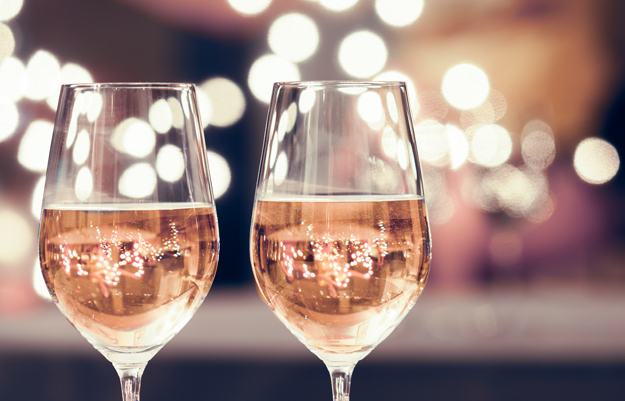
As I am gearing up for a trip to southern France to visit my family, I am in “summer mode.” That includes my wardrobe, activities, food and obviously the wine in my glass! The quintessence of summer to me is simply sipping a glass of rosé on a terrace. I was surprised by the results of a recent survey analyzing wine consumers' behavior. Data indicate that, even during warmer months, wine consumers in the USA choose red or white versus rosé by a ratio of more than six to one… I wonder why these data are so contradictory with what seems (or should be) a common practice. Rosé wine is a perfect choice for those beautiful summer days and an (essential) element to a delightful vacation. It's not a “cliché,” rosé just fits perfectly!
I believe consumers in the USA may have a difficult perception of rosé. Very often people have one bad experience with rosé (strawberry candy “blush,” anyone?) and decide to cross out the entire category. But all rosés are not created equal. Just like red and white wines, there is a wide choice of styles and profiles.
Rosé Basics
The most common method to produce rosé is by crushing red grapes and then leaving the skins in contact with the juice for a short period up to 48 hours (a.k.a. maceration). Skins are removed just after pressing so there is no skin contact during fermentation (unlike red winemaking). The length of skin contact, winemaking techniques as well as grape varietal, influence both the color and taste of the wine.
In the Middle Ages, pale rosé wines were nicknamed “vins d'une nuit” ("wine of one night") since maceration lasted just one night. I love that lyrical touch!
Rosé Styles
For decades, the “rosé category” in the USA was dominated by rather sweet and slightly sparkling rosés from Portugal. This was followed by the commercial success of “Blush” wines or “White Zinfandel” from California. These sweet, pink wines with cotton candy flavors are largely available on shelves in Pennsylvania these days.
European rosés are typically lighter and drier. Navarra and Rioja in Spain regions showcase fruity grape varietals such as Garnacha, Tempranillo or Graciano and are very pleasurable.
The Provence area in southern France (considered the birthplace of rosé!) offers dry and delicate versions that are crisp and refreshing. By far this is my favorite region—OK, I might be a little bit biased.
Rosés from the Rhone area (Tavel in particular) have deeper flavors and aromas and a structure that is closer to red wines.
If rosés from these regions are too dry, I recommend wines from the Loire area in France. Wines from Anjou in particular have an off-dry profile that might be a better fit.
Rosés are produced all around the planet with delicious results. It's worth picking a bottle from Chile or Australia to taste something different.
How to Buy Rosé
My first tip: Don't get fooled by marketing. There is more to rosé than the celebrity name behind the brand. Instead, look for clues on the label: the origin, grape varietal and (hopefully) a little description of the wine with food pairing. And asking for advice or using a wine application on a smartphone can be helpful!
My second tip: Don't go cheap. Low priced rosés usually cause big disappointment. Most rosés are priced below $20 in stores. It's easy to find some delicious and pleasant examples with a price tag around $15. Frugality can meet taste!
Finally, don't be put off by the wine's color. Rosé can be perceived as a girly drink (again, the sweet blush did not help with the image). Men drink rosé the same way they can sport a pink shirt and be extremely stylish and tasteful. My husband is living proof!
The Perfect Refreshing Match for Summer Food
Most rosés should be consumed within a year or two after release as they have a short shelf-life. They usually won't improve with years, so double check the vintage!
What I love most about rosés is their versatility. They work with many types of food and international cuisine. Rosés are best served chilled and add a fresh, crisp and refreshing touch to dishes from grilled meat to salad, or even pizza and grilled fish. A perfect wine for food lovers.
Personally, I will embrace La vie en rose during these warm months and will probably do so until later this fall, simply because it feels and taste so good.
Cheers!

About the Author
Céline Riquelme is an International wine specialist, wine consultant and wine blogger.
A native of France, Céline has worked and lived throughout Europe and the USA and holds the Diploma of the WSET (Wine & Spirit Education Trust). Céline founded “Three Cheers Wine Solutions” based in Center Valley to share her knowledge and passion for wine. Céline helps clients select the best wines to serve during their special events and hosts tailor-made wine tasting experiences as well as wine educational classes. Occasions range from small parties (private dinners, bridal showers) to large gatherings (weddings, networking and charity events, corporate team-building…)
Céline also provides consulting to restaurants to optimize their wine list, train their staff and enhance the restaurants' profile through wine related events.
To learn more about hosting a private wine tasting or get advice regarding wine selection for a future event threecheerswine.com



 threecheerswine
threecheerswine threecheerswine
threecheerswine










